How to Use IconWorkshop™ with Adobe Illustrator®...
If you use Adobe® Illustrator® to create your images, here is how to proceed to work with Axialis IconWorkshop™ using an Illustrator plug-in.
A plug-in is a program extension module. In fact, this is a small a program which is "plugged" (added) into another application to enhance it or add a new feature to it. The plug-in must be compatible with the "parent" application specifications.
Why a Illustrator® plug-in for IconWorkshop™?
We created such a plug-in to permit you to transfer an image or a drawing directly from Illustrator®) to Axialis IconWorkshop™ through the memory.
This is much more fast and secure. No more temporary PNG file to transfer your image into Axialis IconWorkshop™. No more risk to loose your file while transferring it. As the icon format does not yet support vector images, during the transfer the image will be converted from vector to raster. This operation is called a "rasterization". Several options are available to adjust the rasterization.
Before using this plug-in you have to install it in the Illustrator plug-ins directory. Please read this for more info.
Install the Illustrator-to-IconWorkshop™ transfer plug-in
Before using the plug-in, you need to install it on your computer. It can be easily installed from within Axialis IconWorkshop™ in one fast and simple operation.
1. Before installing the plug-in we recommend you to close the Illustrator® application (if it is actually opened in background). Choose File/Install Illustrator® Plug-in...
2. The dialog box Install the Illustrator to IconWorkshopä Transfer Plug-in opens (see below). In the Location edit zone (![]() ), specify the Illustrator plug-in folder. If you don't know the exact folder path, click the browse button (
), specify the Illustrator plug-in folder. If you don't know the exact folder path, click the browse button (![]() ) to choose the folder in a list.
) to choose the folder in a list.
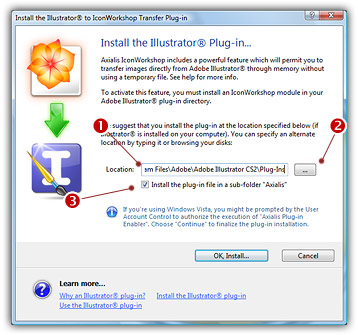
3. If you want to create a subfolder "Axialis" to install the plug-in module (recommended to organize your folder properly), activate the option "Install in a subfolder Axialis" (![]() ). Note that creating a subfolder may fail with some compatible applications.
). Note that creating a subfolder may fail with some compatible applications.
4. Click OK. When done, a message informs you that the plug-in has been installed.
5. Now you can start your Illustrator® application. If your version of Illustrator is CS4 or more, the command is visible in menu Object/Filters/Axialis Software/Transfer to Axialis IconWorkshop. If your version is prior to CS4, it is visible in menu Filter/Axialis/Transfer to Axialis IconWorkshop. Read this for more info on how to use the plug-in filter.
Transferring an Image from Illustrator to IconWorkshop using the plug-in
To use the Illustrator® to IconWorkshop™ plug-in, you must start the Illustrator® application first. The plug-in is accessible from within Illustrator® only. Before using the plug-in as detailed in next topic, you need to install it on your computer as described above.
1. First of all, launch Illustrator® and open or create a document. The Illustrator file used in this topic can be downloaded here: Axialis-Sphere.ai
2. In the document, select the objects you want to transfer to IconWorkshop™ (![]() ). If you don't select objects, the whole document will be transferred.
). If you don't select objects, the whole document will be transferred.
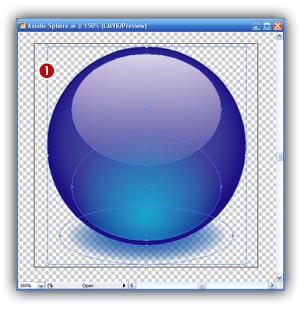
![]() You don't need to launch IconWorkshop™ before using the plug-in. It will be automatically launched by the plug-in if necessary.
You don't need to launch IconWorkshop™ before using the plug-in. It will be automatically launched by the plug-in if necessary.
3. Choose the Filter/Axialis/Transfer to Axialis IconWorkshop™... command in the menu.
4. A dialog box opens (see below). If you have selected some objects in the document, you can choose to export only these objects or the whole document (![]() ).
).
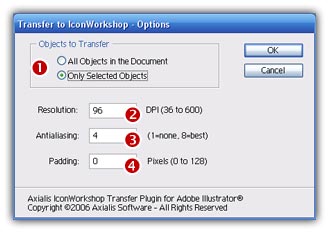
5. During the transfer, the vector objects will be rasterized (i.e. converted to bitmap images composed of pixels). To perform this, you need to specify the Resolution (![]() )of the image to produce in DPI (Dots Per Inch). Based on the size of your vector document and the value you specify here, the size of the final bitmap image will be automatically calculated. For example, if your vector object is 2x2 inches and if you specify 128 DPI, the final image will be 256x256.
)of the image to produce in DPI (Dots Per Inch). Based on the size of your vector document and the value you specify here, the size of the final bitmap image will be automatically calculated. For example, if your vector object is 2x2 inches and if you specify 128 DPI, the final image will be 256x256.
6. Specify a value for the Antialiasing (![]() ). This parameter permits to create a smoother image, especially on edges. The higher, the better, the longer to compute. Finally, specify a Padding value (
). This parameter permits to create a smoother image, especially on edges. The higher, the better, the longer to compute. Finally, specify a Padding value (![]() ) to create a transparent border around the image. This will avoid to have the objects placed directly on the border of the image. A small border permit to create nicer icons, especially when creating the small image sizes.
) to create a transparent border around the image. This will avoid to have the objects placed directly on the border of the image. A small border permit to create nicer icons, especially when creating the small image sizes.
7. When done, click OK. Axialis IconWorkshopä is automatically launched (or activated if running in background) and the dialog box Install the Illustrator® to IconWorkshop™ Transfer Plug-in opens (see below).
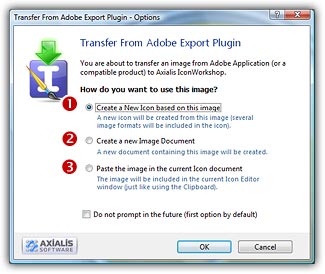
8. The image is about to be transferred in IconWorkshop™. You can choose one of the following operations: Create a New Icon using this Image (![]() ): You create a new icon with several formats based on the image (see step 4); Create a New Image Document (
): You create a new icon with several formats based on the image (see step 4); Create a New Image Document (![]() ): IconWorkshop™ opens a new document containing the image. You'll be able to perform various operations on the image (resize, crop, save...) and even create a new icon from a portion of it; Paste the Image in the Current Icon Document (
): IconWorkshop™ opens a new document containing the image. You'll be able to perform various operations on the image (resize, crop, save...) and even create a new icon from a portion of it; Paste the Image in the Current Icon Document (![]() ): This option is enabled only if an icon document is already opened in IconWorkshopä. It pastes the image in the current editor area (just like the Clipboard paste operation).
): This option is enabled only if an icon document is already opened in IconWorkshopä. It pastes the image in the current editor area (just like the Clipboard paste operation).
9. If you choose the first option (Create a New Icon using this Image), the following dialog box opens (see below). As IconWorkshop™ support creation of both Windows® and Macintosh® icons, you're prompted to choose the format. Select option ![]() for Windows® or option
for Windows® or option ![]() for Macintosh®.
for Macintosh®.
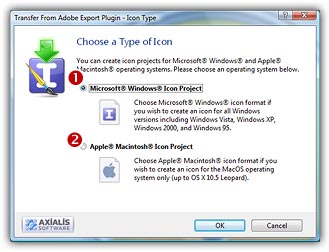
10. By choosing Windows®, the following dialog box opens (a similar dialog opens if you choose Macintosh®)
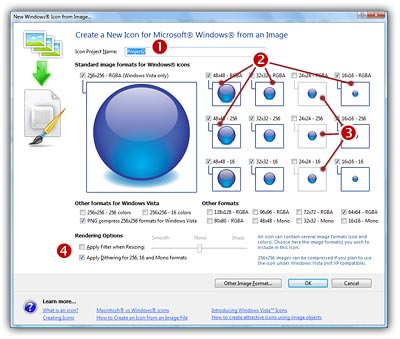
11. In the Name group (![]() ), enter the icon project name. Do not specify any extension.
), enter the icon project name. Do not specify any extension.
12. In the Image Formats group, select the image formats you whish to add in the icon (![]() ) and unselect the unwanted images (
) and unselect the unwanted images (![]() ). Just click on the image preview to select/unselect. To know more about the desired Windows® standard image format, see What is an Icon topic.
). Just click on the image preview to select/unselect. To know more about the desired Windows® standard image format, see What is an Icon topic.
13. You can also apply or not the dithering option to the 256/16 color images as well as add a filter effect to smooth/sharpen the resulting images in RGB/A mode (try ![]() and see the results in the preview images).
and see the results in the preview images).
14. If you wish to start creating your icon with an unlisted format, click the Other Image Format button.
15. When done, click OK. The icon is automatically created with the various image formats you've selected.